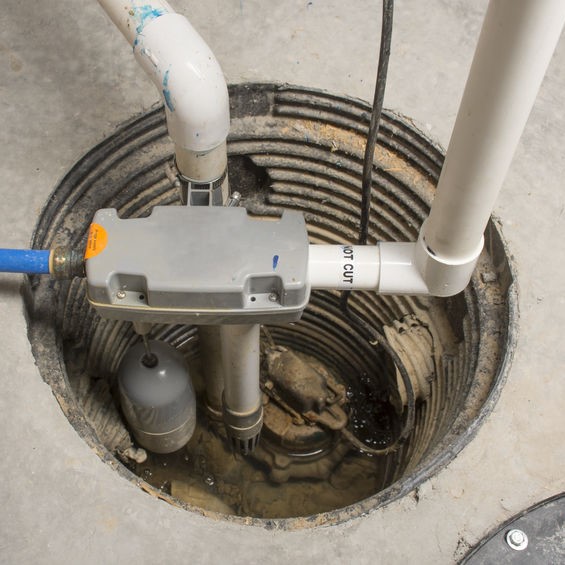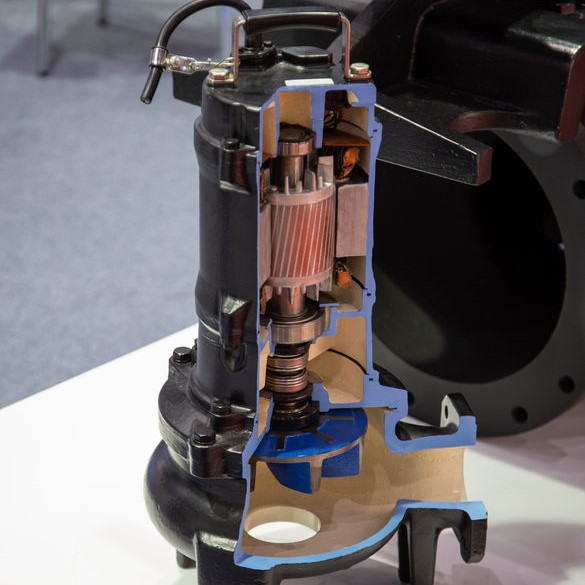
What does the sump pump do?
Sump pumps, usually located in the basement or crawl space, in a corner, against an outside wall, channels water away from a sump basin. There are two types of sump pumps:
- Submersible sump pumps
- Pedestal sump pumps
A Navy electrician invented the sump pump in 1946 and ever since that time, the sump pump is a common fixture in many homes today, especially those with a basement. Home that were built in the 1980s were often constructed below the water table or on a floodplain. This necessitated having a sump pump for most of those homes and in1987, sump pump for basement became required by the U.S. Federal Clean Water Act for any new construction.
After locating your sump pump, uncover the debris that is often covering one and look inside the unit. There are multiple holes in the wall of a sump basin, each one connected to a drainpipe. Some drainpipes extend from weeping pipe tiles on your home’s foundation exterior. Other drainpipes connect to the basement’s interior drainage system.
As groundwater accumulates on the exterior of the foundation or under the basement floor, it flows into the sump basin through a drainpipe. When it has reached a certain level, the sump pump automatically turns on.
There is a sump pump and pit, and inside the sump pump is a impeller that pulls water from the sump pit and with centrifugal force, pushes that water up into a discharge pipe. The water is then emptied from the discharge pipe out and away from the foundation. Some setups are for the sump pump to sewer downhill from the foundation.
There are two methods for activating a sump pump:
- A pressure sensor: This signals the pump when the water pressure has exceeded the specified level.
- A float activator arm: This has a buoyant ball attached that floats on the water’s surface and when the water has reached a certain height, the sump pump is activated.
Do all basements need a sump pump?
No, not every house with a basement is prone to flooding. A house that is constructed over a pit or below the water level of the area has the tendency to flood and would need a sump pump in the basement. The sump pump eliminates moisture and keeps a home from flooding by collecting any excess water and pumping it away from the house.
Do sump pumps need maintenance?
If your home has a sump pump, then it is as necessary as any other appliance in your home, and yes, it will need occasional maintenance in order to work when you need it to work. A sump pump prevents water from entering the basement, pulling it from around the foundation and draining it somewhere downhill and away from your home and the foundation. The following are tips that help you keep your sump pump ready for action:
- Monthly: A sump pump that disposes of washing machine water should be cleaned monthly. Unplug the unit first, remove and clean the screen, then return the screen, plug the unit back in and test.
- Quarterly: A sump pump that doesn’t dispose of water from the washing only needs cleaning every 3 months.
- Annually: Once a year, clean the pump and pit is recommended.
Once a year, hiring a professional to inspect your sump pump is the same has having your HVAC system inspected each year. It is a maintenance appointment that will make sure your sump pump is ready for action when needed. Check your sump pump’s manual and following the manufacturer’s recommendation is always the safest way to assure you unit will be ready when you need it.

Do sump pumps make noise?
A normal operating sump pump will make some noise from the air that comes before the water that is flowing through the piping. The better made, higher-quality pump won’t make as much noise but the older a sump pump gets, the louder it will get. If your sump pump is loud, there are are some noises that are not normal and you should have a professional plumber inspect the unit. Those noises are:
- Clanging: Much like any plumbing pipes in your home clanging noise from your sump pump indicates the pipe is hitting the basin or the well wall. This can be remedied by wrapping the pipe with foam insulation or placing rubber stoppers under sump pump lid so that it can’t make any connection with the interior components. The same type of stoppers can quiet rattling motor noises too.
- Gurgling: This sound, or a slurping noise, is typically from a standard check valve. A plumber can install a spring-loaded replacement valve that may eliminate that noise.
- Motor Noise: Older sump pump models that are constructed from plastic or PVC are nosier than the durable iron sump pumps made today. Sump pumps today have self-lubricating motors that allow them to operate quietly. If your older model sump pump motor is getting noisier and the rubber stoppers didn’t eliminate that noise, it may be time to replace your sump pump.
If your home came with a sump pump installed, it needs to be there for a reason. If it did not come with one and you need one, or the one you have needs to be replaced, this is an expense that you likely are not prepared for, but the results of the work they do is worth the cost. In most cases, sump pumps that are maintained as recommend can last for a long time. How many years does a sump pump last? All appliances and equipment in will need replacing at some point, including a sump pump. Fortunately, they have an average lifespan of 10 years. The cost of a sump pump will vary from region to region, but the average cost for installing a sump pump is just over $1,000 and upward to $1200. Call 317-677-4918 today for your sump pump repair needs in Indianapolis, IN.
